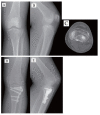Treatment of the Posterolateral Tibial Plateau Fractures using the Anterior Surgical Approach
- PMID: 23675208
- PMCID: PMC3615285
Treatment of the Posterolateral Tibial Plateau Fractures using the Anterior Surgical Approach
Abstract
Background: Fracture of the posterolateral tibial plateau is relatively uncommon. While surgical treatment by the posterior approach is theoretically ideal, this approach is associated with numerous complications. We describe a series of fractures of the posterolateral tibial plateau treated by the anterior surgical approach.
Methods: Fifteen patients with posterolateral tibial plateau fractures were included in this study. All patients were treated operatively using the anterior approach. The quality of fracture reduction was evaluated and functional results were estimated by the Hospital for Special Surgery knee scoring system.
Results: The most common cause of fracture was a motor scooter accident (86%, 13 of 15 patients), which may have resulted in the protective front plate of the scooter hitting the knee in the flexion position, causing an axial compression and valgus force, resulting in the fracture of the posterolateral tibial plateau. The average knee motion after surgery was 0-124° of flexion and 14 out of 15 patients (93%) experienced satisfactory articular reduction. There were no postoperative neural or vascular injuries and no wound complications. The average Hospital for Special Surgery knee score was 92 (range, 74-98).
Conclusions: In our series, with careful preoperative planning, the anterior approach for the surgical treatment of posterolateral tibial plateau fractures had no complications and was associated with satisfactory outcomes.
Keywords: anterior approach; posterior aspect; tibial plateau fracture.
Figures
Similar articles
-
Revisiting the flexion-valgus type unicondylar posterolateral tibial plateau depression fracture pattern: classification and treatment.J Orthop Surg Res. 2023 Nov 2;18(1):825. doi: 10.1186/s13018-023-04318-y. J Orthop Surg Res. 2023. PMID: 37919777 Free PMC article.
-
A combined approach for the treatment of lateral and posterolateral tibial plateau fractures.Injury. 2016 Oct;47(10):2326-2330. doi: 10.1016/j.injury.2016.07.004. Epub 2016 Jul 5. Injury. 2016. PMID: 27440528
-
The anterolateral supra-fibular-head approach for plating posterolateral tibial plateau fractures: A novel surgical technique.Injury. 2016 Feb;47(2):502-7. doi: 10.1016/j.injury.2015.11.010. Epub 2015 Nov 22. Injury. 2016. PMID: 26684172
-
Fibular head osteotomy: a new approach for the treatment of lateral or posterolateral tibial plateau fractures.Knee. 2010 Oct;17(5):313-8. doi: 10.1016/j.knee.2010.01.002. Epub 2010 Feb 18. Knee. 2010. PMID: 20163966 Review.
-
Diagnosis and Treatment of Anterior Tibial Plateau Fracture-Dislocation: A Case Series and Literature Review.J Knee Surg. 2017 Feb;30(2):114-120. doi: 10.1055/s-0036-1581136. Epub 2016 Apr 27. J Knee Surg. 2017. PMID: 27119967 Review.
Cited by
-
Partial Fibular Head Osteotomy is an Alternative Option in Treatment of Posterolateral Tibial Plateau Fractures: A Retrospective Analysis.Front Surg. 2022 May 9;9:915814. doi: 10.3389/fsurg.2022.915814. eCollection 2022. Front Surg. 2022. PMID: 35615654 Free PMC article.
-
Comparison Between Treatment of Bicondylar Tibial Plateau Fractures With or Without Posterolateral Fragments Using Posteromedial and Anterolateral Approaches.Indian J Orthop. 2022 May 29;56(8):1347-1353. doi: 10.1007/s43465-022-00654-z. eCollection 2022 Aug. Indian J Orthop. 2022. PMID: 35928656 Free PMC article.
-
An osteotomy anterolateral approach for lateral tibial plateau fractures merged with relatively simple and intact posterolateral corner displacement.J Orthop Surg Res. 2014 Apr 15;9:26. doi: 10.1186/1749-799X-9-26. J Orthop Surg Res. 2014. Retraction in: J Orthop Surg Res. 2015 Mar 26;10:47. doi: 10.1186/s13018-015-0176-x. PMID: 24735864 Free PMC article. Retracted.
-
A systematic analysis assessing epidemiological characteristics and surgical outcomes of posterolateral tibial plateau fractures.Eur J Med Res. 2025 Aug 29;30(1):823. doi: 10.1186/s40001-025-03058-5. Eur J Med Res. 2025. PMID: 40883781 Free PMC article.
-
An imageology-based feasibility study of plating posterolateral tibial plateau fractures via an anterolateral trans-fibular-head approach.BMC Musculoskelet Disord. 2024 Mar 5;25(1):196. doi: 10.1186/s12891-024-07311-6. BMC Musculoskelet Disord. 2024. PMID: 38443852 Free PMC article.
References
-
- Chang SM, Zheng HP, Li HF, et al. Treatment of isolated posterior coronal fracture of the lateral tibial plateau through posterolateral approach for direct exposure and buttress plate fixation. Arch Orthop Trauma Surg. 2009;129(7):955. - PubMed
-
- Tao J, Hang DH, Wang QG, et al. The posterolateral shearing tibial plateau fracture: treatment and results via a modified posterolateral approach. Knee. 2008;15(6):473. - PubMed
-
- Waldrop JI, Macey TI, Trettin JC, et al. Fractures of the posterolateral tibial plateau. Am. J. Sports Med. 1988;16(5):492. - PubMed
-
- Honkonen SE. Indications for surgical treatment of tibial condyle fractures. Clin. Orthop. Relat. Res. 1994;302:199. - PubMed
-
- Ranawat CS, Insall J, Shine J. Duo-condylar knee arthroplasty: hospital for special surgery design. Clin. Orthop. Relat. Res. 1976;120:76. - PubMed
LinkOut - more resources
Full Text Sources

